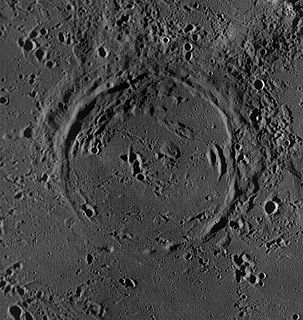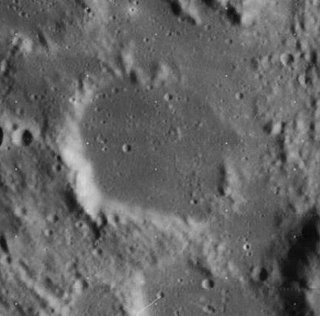
Daguerre is a circular formation near the north end of Mare Nectaris. To the west-northwest is the crater Mädler, and beyond it to the west is the prominent Theophilus. To the north in the rugged continental area between the maria is Isidorus.

Dembowski is a lunar impact crater located to the southeast of the Sinus Medii. Its diameter is 26 km. It was named after Italian astronomer Ercole Dembowski. To the east are the craters Agrippa and Godin, to the southwest is Rhaeticus.

Lick is a lunar impact crater that has been flooded with basaltic lava. This crater was named in memory of James Lick, a Californian philanthropist. The north rim is attached to the smaller, bowl-shaped crater Greaves. Lick lies on the southwest edge of Mare Crisium. Its rim is broken at the north and south ends, and the southwest rim is attached to the crater remnant Lick A. There is a small, flooded crater within the southern part of Lick's inner floor, and several tiny craters mark the interior surface. A small, unnamed crater at the east rim has a bright ray system.

Asada is a small lunar impact crater located at the northern edge of Mare Fecunditatis, to the northeast of the crater Taruntius. It is a circular crater formation with inner walls that slope down toward a small central floor at the midpoint. Asada was designated Taruntius A prior to being named by the IAU.

Cameron is a small lunar impact crater that lies across the northwest rim of the crater Taruntius. It was named after American astronomer Robert Curry Cameron, by his wife, lunar specialist Winifred Cameron. This formation is circular and cup-shaped, with no particular distinguishing features. It was previously designated Taruntius C.

Taruntius is a lunar impact crater on the northwestern edge of Mare Fecunditatis. It was named after ancient Roman philosopher, mathematician and astrologer Lucius Tarutius Firmanus. To the northwest is the lava-flooded crater Lawrence, and to the north lie the craters Watts and da Vinci.

Bonpland is the remains of a lunar impact crater that is attached to the walled plain Fra Mauro to the north and Parry to the east. The intersection of their rims forms a three-pointed mountainous rise. To the southeast is the small crater Tolansky. Bonpland lies on the eastern edge of Mare Cognitum. It is named after Aimé Bonpland, a French explorer and botanist.

Doppelmayer is the remains of a lunar impact crater that lies on the southwest edge of Mare Humorum. It was named after the German mathematician and astronomer Johann Gabriel Doppelmayr. To the south-southeast is another flooded crater designated Lee, and to the southeast is Vitello. Just to the east-northeast of Doppelmayer lies the nearly submerged crater Puiseux.

Artamonov is a lunar impact crater that is located on the far side of the Moon. The eroded outer rim of Artamonov does not have the circular shape of most lunar craters, and instead has the overall shape of three or four merged craters. The largest of these formations is in the south, with smaller circular bulges to the north and east.

Baily is the remnant of a lunar impact crater on the boundary between Mare Frigoris to the north and Lacus Mortis to the south. The crater interior has been flooded by lava in the past, and only the northern half of the crater rim remains relatively intact. There is an outward bulge in the northeastern rim, possibly the remnant of another crater formation that once overlapped Baily. The crater interior is flat and relatively featureless, with no impacts of significance. The surviving outer rim reaches a maximum elevation of about 0.5 km.

Bohr is a lunar impact crater that is located near the western lunar limb, in the area that is affected by librations. It is attached to the southwestern rim of the larger, eroded Vasco da Gama formation, and to the southeast of the crater Einstein. The crater was observed for the first time in 1963, by Arthus and Ewen Whitaker in the book Rectified Lunar Atlas.

Chamberlin is a lunar impact crater that is located on the far side of the Moon, just past the southeastern limb. It lies to the southeast of the crater Jeans, and Moulton is attached to the southeastern rim of Chamberlin. This crater is located in a part of the lunar surface that has undergone resurfacing of crater interiors, producing dark-hued crater floors.

D'Arrest is a lunar impact crater that is located in the lava-flooded region to the west of the Mare Tranquillitatis. It is named after the German astronomer Heinrich Louis d'Arrest. It lies to the southeast of the crater Agrippa and northwest of Delambre. Just to the northeast are the small, bowl-shaped craters De Morgan and Cayley.

Baldet is a lunar impact crater that is located on the southern hemisphere on the far side of the Moon. It lies in the lava-flooded region between the craters Cori to the north, Stoney to the southwest, and the worn walled plain Minkowski to the southeast.

Berosus is a lunar impact crater that is located in the northeast part of the Moon, less than one crater diameter northwest of Hahn. Further to the east-northeast is the large crater Gauss, and to the north-northwest lies Bernoulli. Because of its location, this crater appears foreshortened when viewed from the Earth.

Lawrence is a lunar impact crater that is located on a section of terrain to the east of Mare Tranquillitatis and northwest of Mare Fecunditatis. It was named after American physicist and Nobel laureate Ernest Lawrence and American astronaut Robert Henry Lawrence, Jr.. To the southeast is the larger crater Taruntius. The rille designated Rima Cauchy crosses the eastern part of the Mare Tranquillitatis and reaches as far as the northern rim of Lawrence.

Cusanus is a lunar impact crater that is located near the northeastern limb of the Moon. In this location the crater appears very foreshortened when observed from the Earth, and its visibility is affected by libration. The northern rim of Cusanus is nearly joined to the south-southeastern rim of the larger crater Petermann. To the west is Baillaud and to the southeast is Hayn.

da Vinci is a lunar impact crater that is located in the eastern part of the Moon, to the northwest of Mare Fecunditatis. It lies along the eastern shore of the Sinus Concordiae, a bay along the eastern edge of Mare Tranquillitatis. Nearby craters include Watts to the southeast and Lawrence to the southwest, both smaller in dimension than da Vinci.

Chevallier is a lunar impact crater that is located in the northeastern part of the Moon's near side, about a crater diameter east-southeast of the prominent crater Atlas. To the south-southeast of Chevallier is the flooded crater Shuckburgh.

Cichus is a lunar impact crater that lies in the southwestern part of the Moon, at the eastern edge of Palus Epidemiarum. Just to the northeast and nearly contacting the rim is the lava-flooded crater remnant Weiss. The crater is named after Italian astronomer Cecco d'Ascoli.





















